Simple Vegan Grocery List For Beginners
Food shopping can be a tedious task for everyone, and that’s why we always go to the store or market with our trusty old vegan grocery list.
Even if you’re an experienced plant-based shopper and know your way around the aisles, it’s easy to get overwhelmed—ending up with a cart filled with random items and a lacklustre vegan pantry.
This can spiral to a never-ending cycle where you don’t have the vegan staples to feel inspired in the kitchen, and instead, you reach for that boring, greasy fast food again and again.
And apart from being unhealthy, eating out or ordering takeout multiple times a week can put a strain on your wallet as well!
This is why taking a moment during the weekend (or any day) to write down your master vegan grocery list is so crucial. And if you’re new to veganism, this is where you’ll learn all of your pantry basics and stock your kitchen with the essential ingredients that will allow you to cook with confidence.
Moreover, chances are you’ll be surprised by the abundance of cheap and healthy vegan foods readily available across most supermarkets.
Planning out a vegan grocery list and keeping stock of your pantry can be especially useful for new vegans just starting their vegan journey in non-vegan households.
Even if your fridge has some animal products and your family is cooking non-vegan dishes, you can always reach for your pantry staples while preparing your delicious plant-based meals. And in time, your household members might end up enjoying your vegan cooking more than their animal-derived foods!
In this post, we’re going to give an example of ingredients when shopping plant-based. We aim to show you what’s possible. From there, it’s up to you to decide what staples match your lifestyle goals. Let’s get into it!
Non-vegan ingredients (including the hidden ones)
Let’s get started with the basics. Here’s a list of items that vegans don’t eat and indeed won’t find on our simple vegan grocery list:
- Meat and its bi-products like lard, tallow etc.
- Poultry
- Seafood (fish and shellfish)
- Gelatin
- Whole fresh eggs, egg powder, egg white powder etc.
- Dairy milk, milk fat, milk solids, milk powder, ice cream, cream and yoghurt
- Dairy cheeses
- Butter and ghee
- Honey, bee pollen, beeswax and royal jelly
- Whey, casein and lactose
- Shellac
While meat, dairy, and eggs might be obvious off-limits ingredients even for the new vegans just transitioning to veganism, there are plenty of hidden animal-derived ingredients that end up in many unexpected products. There are many others, but what we’ve listed above are the most common.
Many of these ingredients are known for making their way into bread, non-dairy cheeses, coffee creamers, commercial cereals, and sweets.
A quick scan of the ingredient list on the packaging is enough to check for most of these non-vegan ingredients. Check out this resource to learn more about the hidden additives.
Planning your vegan grocery list
When starting as a new vegan, you might be surrounded by claims that vegans only eat lettuce or broccoli. This couldn’t be further from the truth!
Veganism is a lifestyle of abundance and not restriction. You’ll soon realise this for yourself after going through all the delicious foods featured in the list.
We intend to cover as many vegan foods as possible in this post, though we don’t expect you to go out and buy them all. In fact, we certainly don’t recommend that.
Use this article as a guide to creating a vegan grocery list tailored to your needs and food preferences so you can shop with confidence on your next trip to the grocery store.
Even more importantly, use the bounty of plant-based ingredients as inspiration to try and experiment with new vegan dishes.
While we decided to cover all of our bases here and feature all the food groups, chances are you already have some items listed below in your fridge or pantry.
Think of basic household staples like flour, rice, pasta, some fruits and vegetables, canned or dried beans, and tomato sauce.
Use the ingredients you already have on hand to build your weekly meal plan and then shop to supplement what’s missing.
You don’t need to create an elaborate schedule with strict recipes, just make a note of what you plan on cooking and eating for the upcoming week. And as you get more comfortable in the kitchen, you can experiment with new recipes.
Maybe try out some quinoa or buckwheat as the grain staple for the week if you’ve been eating mostly rice thus far. Or swap the kidney beans for some white or black beans or even red lentils. Play around with new vegetables in your soups and stews. The options are endless!
Vegan grocery list and pantry essentials
We always keep our pantry stocked with some essential ingredients like beans, rice, oats, quinoa, oils, vinegar, tomato products, non-dairy milk, and nutritional yeast.
These are the items that will last a long time and will go a long way in adding substance and flavour to your meals. You can top these up with the fruits and veggies you enjoy or ingredients you know will work well with your planned meals for the week.
For example, we like adding bananas, dates, and berries (frozen when not in season) to our cart to go with our morning oats and smoothies.
Our simple vegan grocery list includes the following food categories:
- Vegetables (fresh, frozen, and canned)
- Legumes (dried and canned)
- Nuts and Seeds
- Fruits (fresh, dried, and frozen)
- Grains
- Soy Products
- Natural Sweeteners
- Dairy Alternatives
- Meat Alternatives
- Snacks and Treats
- Beverages
- Condiments
- Bread and Pasta
Below is a breakdown of each category.
Vegetables
Undoubtedly the most nutritious group of this bunch, vegetables will be the main focus point on your shopping list. They’re rich in vitamins, minerals, antioxidants, and fibre; while being low in calories so you can eat as much as you desire.
The key with vegetables is to eat the rainbow. Different coloured veggies will have different vitamins and minerals. So including a variety of colours with each week is the way to go.
Look for your reds, greens, yellows, and purples as a starting point. Green leafy vegetables are especially beneficial as they are the most-nutrient packed option available. So make sure to get your daily dose of spinach, kale, or lettuce.
Another critical thing to keep in mind when buying your vegetables is to look for seasonal options whenever you can. If you’re not sure where to start with buying what’s in season, just visit the nearest farmers market where you’ll find the local produce bounty, and you can get whichever vegetables look and smell the best to you.
We encourage you to start at the organic stalls as they’ll only have what’s in season. Just note that some growers will still be able to produce everything under the sun depending on their growing methods and where they’re located.
There’s nothing wrong with getting the occasional out-of-season vegetable for a particular recipe you want to test. Still, you’ll get the most flavour and nutrients from seasonal veggies.
Buying seasonal veggies will also keep your vegan grocery list on a budget as imported produce can rack up your bill quickly. Not to mention, shopping seasonally helps to reduce your footprint by reducing the milage of the produce being imported.
Our go-to vegetables are onions, garlic, potatoes, carrots, broccoli, spinach, zucchini, salad mixes, pumpkin, cauliflower, eggplant, chard, sweet potatoes, and tomatoes. However, we always switch out this list for what’s in season. We get mostly fresh vegetables with some frozen and very little canned.
Fresh vegetables
- Leafy greens: spinach, kale, chard, collard greens, arugula, lettuce, beet greens, radicchio, watercress
- Root vegetables: potatoes, carrots, parsnips, sweet potatoes, turnips, rutabagas, beets, daikon, ginger, celeriac, onions, garlic, fennel, Jerusalem artichokes and radishes
- Cruciferous vegetables: broccoli, cauliflower, cabbage varieties, Brussels sprouts, kohlrabi
- Peppers (including spicy peppers, aka capsicum)
- Tomatoes (technically a fruit)
- Avocadoes (technically a fruit)
- Cucumbers
- Zucchini
- Eggplant
- Asparagus
- Artichokes
- Celery
- Leeks
- Shallots
- Mushrooms (of all kinds)
- Butternut squash
- Pumpkin
- Green beans
- Peas
- Okra
- Corn
Frozen vegetables
Frozen vegetables are picked and flash-frozen during their peak season, so they’re just as nutritious as their fresh counterparts. We like keeping some frozen peas, green beans, corn (always organic) and broccoli for quick stir-fries and soups.
- Peas
- Green Beans
- Carrots
- Broccoli Florets
- Cauliflower Florets
- Brussels Sprouts
- Asparagus
- Corn
- Frozen vegetable medley for stir-fries and stews
Canned and jarred vegetables
Canned and jarred vegetables can quickly ramp up your sodium intake for the day, so they should be second priority to fresh. We mostly use low-sodium canned tomato products, olives, gherkins, sauerkraut, capers and sometimes red peppers.
- Tomato Products: diced tomatoes, whole tomatoes, tomato paste, tomato passata
- Pumpkin purée
- Artichokes
- Baby corn, carrots and peas
- Potatoes
- Mushrooms
- Water chestnut
- Beetroot
- Olives
- Capers
- Onions
- Jalapenos
- Gherkins
- Sun-dried tomatoes
- Roasted red peppers
- Sauerkraut
- Asparagus
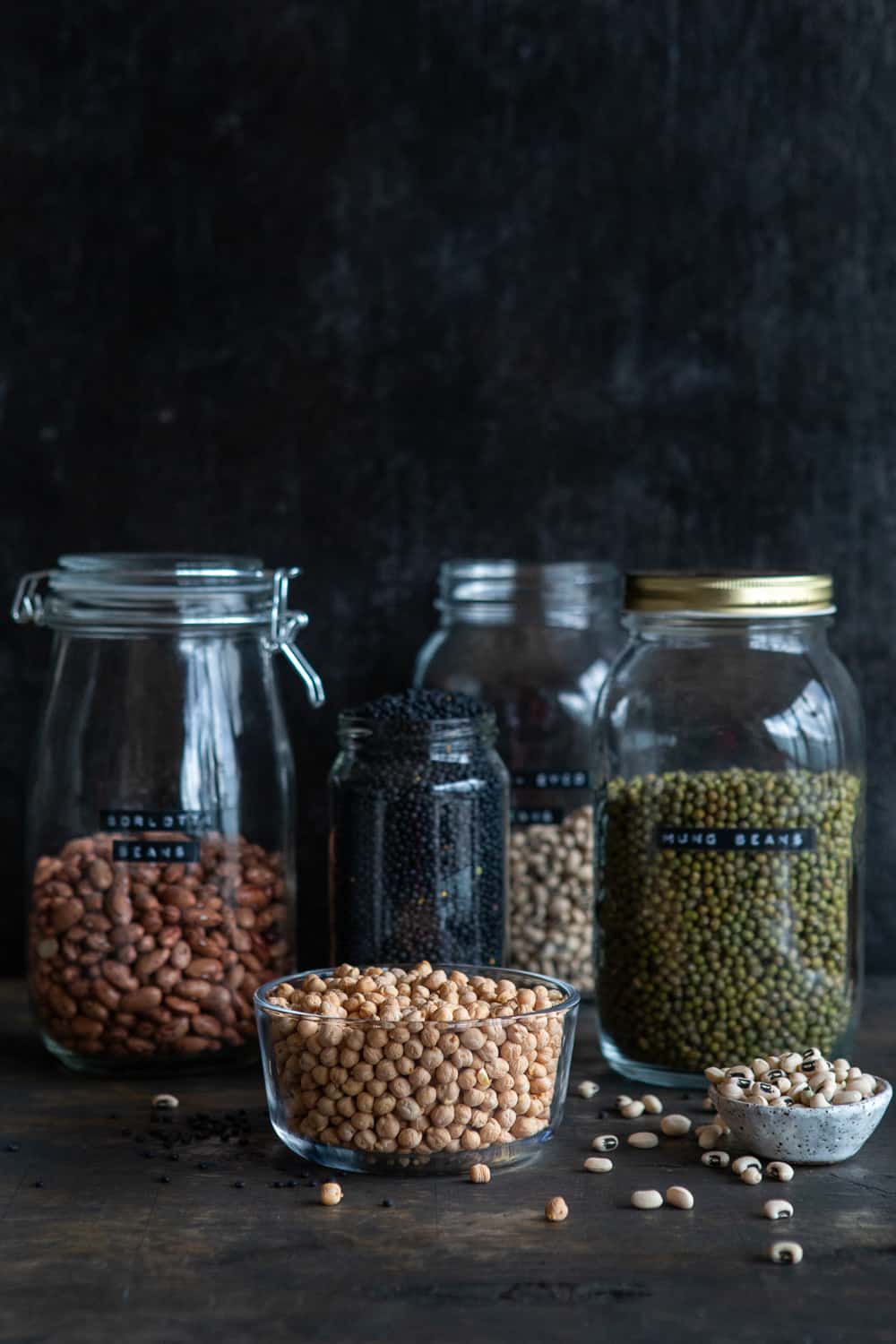
Legumes
Legumes are another important component of a vegan pantry as they offer ample amounts of protein and fibre, as well as tons of essential vitamins and minerals.
Beans and lentils will add bulk and sustenance to your soups and stews, though they can also be used as the main ingredients in lots of recipes. Think of chickpeas in hummus and falafel or black beans for vegan burgers.
Using canned beans and lentils is excellent for convenience as they’re already cooked and can be used to make quick meals. Don’t forget to rinse and drain your canned legumes under some cold water to remove some of the sodium (if salt is one of the ingredients listed on the can).
If you’re looking to save some money and plan out a vegan grocery list on a budget, dried beans and lentils are the way to go. They’re a great zero-waste option too as you can buy them from the bulk bins in your grocery store. You do need to plan a bit and cook your dried legumes in advance, so keep that in mind.
Dried legumes
- Black beans
- Red kidney beans
- White beans (aka cannellini)
- Navy beans
- Pinto beans
- Red lentils
- Green lentils
- Brown lentils
- Split peas
- Chana dal
- Mung beans
- Lima beans (aka butter)
- Borlotti beans
- Chickpeas (garbanzo beans)
- Beluga beans
- Black-eyed beans/peas
- Adzuki beans
Canned legumes
- Black beans
- Red kidney beans
- White beans (aka cannellini)
- Red lentils
- Borlotti beans
- Chickpeas
- Lima beans (aka butter)
- Navy beans
- Brown lentils
- 2, 3, or 4 bean mixes
Nuts and seeds
Nuts and seeds are your primary source of essential fatty acids, including the all-important omega 3’s. They also offer some protein and fibre, as well as lots of other nutrients, including vitamin E, magnesium, and zinc.
Nuts and seeds are great additions to your morning oats or smoothies, but you can also use them to make your own homemade dairy-free milk. You can get them raw or as nut/seed butter.
The humble cashews are a vegan’s best friend as they can be used as the base for various homemade vegan cheeses, pasta sauces, dips, and delicious vegan desserts. Just soak them in cold water for 8 hours and blend away!
Nuts
- Almonds
- Peanuts (technically a legume)
- Walnuts
- Cashews
- Pine nuts
- Pistachios
- Pecans
- Macadamias
- Brazil nuts
- Hazelnuts
- Nut butters (can be made with a combination of the nuts listed or as individual butters like peanut or almond)
Seeds
- Flaxseeds
- Chia Seeds
- Sesame seeds (black and white)
- Hemp seeds
- Poppy seeds
- Sunflower seeds
- Pumpkin seeds (aka pepitas)
- Seed butter (pumpkin seed butter, sunflower seed butter, tahini—made from sesame seeds)
Fruits
Dubbed nature’s candy for a good reason—fruits are a true nutritional powerhouse and one of the rare sweet treats that you can feel good about eating. They’re packed with tons of vitamins, minerals, antioxidants, and fibre. However, do keep in mind that some fruits are higher in natural sugar (fructose) than others, so don’t go crazy!
This category is similar to the vegetables in several regards. We already mentioned that you’d get the maximum nutrients out of vegetables when you include them in your diet in all the colours that they come in and the same is true with fruits.
Vary your fruit intake to include some red, green, yellow, purple, and orange fruits each week. Also, just like with the vegetables, visit your farmer’s markets for seasonal, locally grown fruit. This way you’ll get maximum flavour at minimum cost—while reducing your footprint.
We like getting a variety of fresh and frozen fruit, along with some dried. Bananas and berries are staples in our household, though we also like apples, peaches, plums, mangoes, and various citrus fruits when in season.
Fresh fruit
- Bananas
- Apples
- Pears
- Plums
- Peaches
- Nectarines
- Apricots
- Cherries
- Pomegranates
- Figs
- Grapes
- Mango
- Pineapple
- Passionfruit
- Papaya
- Dragon fruit
- Berries: strawberries, raspberries, blackberries, blueberries, currants, gooseberries, cranberries
- Citrus fruit: oranges, lemons, limes, grapefruits, tangerines, pomelo
- Watermelon
- Melon
Frozen fruit
We like keeping some frozen berries for smoothies as they give a very creamy and thick texture. More importantly, frozen berries are a lot cheaper in the winter when fresh berries aren’t readily available.
- Berries: strawberries, raspberries, blueberries, mixed berry blends, sour cherries
- Mango chunks
- Pineapple chunks
- Peaches
- Mixed fruit blends for smoothies
Dried fruit
Dried fruits can be healthy in moderation. They’re very sweet and packed with nutrients, though be careful with your dried fruit intake as they can add up the calories and sugar pretty fast.
We like dates for our raw desserts or bliss balls, dried apricots as a snack, and dried coconut for our homemade granola.
- Dates
- Cherries
- Apricots
- Raisins, sultanas and currants
- Cranberries
- Orange peel
- Bananas
- Pineapple
- Blueberries
- Raspberries
- Mango slices
- Apple slices
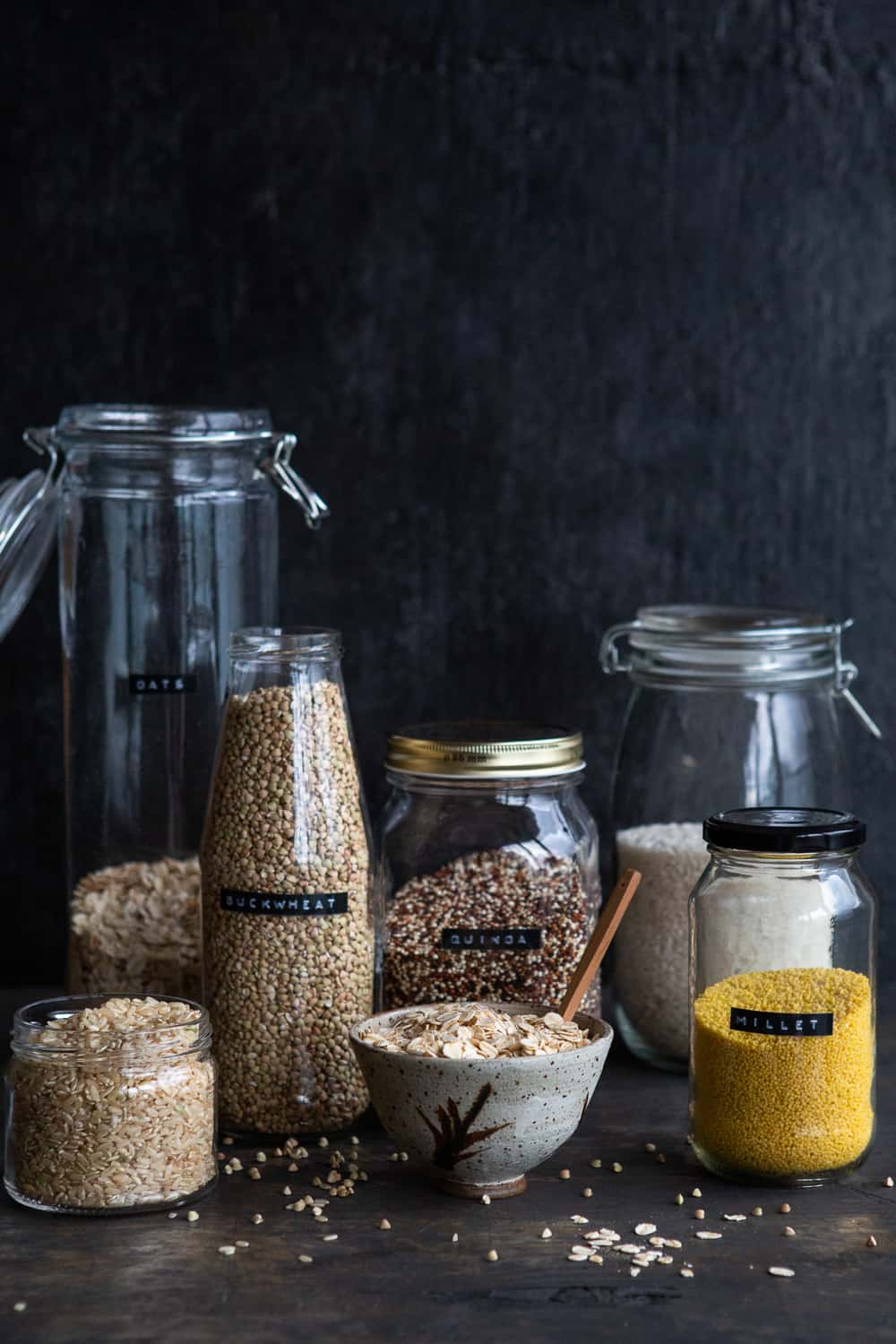
Grains
Grains are the necessary pantry staples that will help you create delicious and filling meals and load you up on fibre amongst other minerals.
Whole grains form the basis of a whole-foods plant-based diet as they’re your primary carb source for energy throughout the day.
Always look for the most minimally processed grain options you can get, e.g. rolled or steel-cut oats as opposed to instant oatmeal. And if you find yourself in a rut with just plain old rice over and over again, use this list as inspiration to try out something new.
We always stock a variety of rice, buckwheat, millet, oats, and quinoa in our pantry for both sweet and savoury dishes.
If you enjoy a slice of banana bread with your morning coffee or just like baking in general, you’ll also need a couple of flour options.
Whole-grain pastry flour is the most basic one, though almond and coconut flours can be useful for gluten-free baking.
Chickpea flour is another great flour to add to your vegan pantry—you can make all kinds of delicious savoury dishes with it‚ including high-protein pancakes!
Different types of grains
- Rice: brown, red, black, jasmine, medium grain, arborio, short-grain sushi rice, basmati and wild (wild rice is actually an aquatic grass, not a grain!)
- Quinoa (technically a seed)
- Rolled oats
- Millet
- Buckwheat
- Amarant
- Barley
- Farro
- Wheat and bulgur (aka cracked wheat)
- Freekeh
- Teff
- Sorghum
- Rye
Flours
- Whole-wheat pastry flour
- Rice flour (brown or white)
- Millet flour
- Quinoa flour
- Buckwheat flour
- Sorghum flour
- Oat flour
- Almond flour
- Coconut flour
- Chickpea flour (aka besan flour)
- Banana flour
- Corn maise flour
- Rye flour
- Tapioca flour/starch
- Potato flour or starch
- Arrowroot flour
Soy products
Despite the lousy rep soy has been getting lately, soy products (ideally fermented) are a healthy addition to your vegan diet. They’re a complete protein source—containing all 9-essential amino acids.
Soy milk ranks up very high among non-dairy milk for its high protein and calcium content, as well as its creamy texture. Try and always buy organic, non-GMO soy for the best quality.
- Tofu: firm, extra-firm, medium, and silken
- Edamame (fresh or frozen)
- Unsweetened soy milk
- Soy protein curls/mince (TVP)
- Tempeh
Natural sweeteners
We like to use coconut sugar with our coffee and drizzle a bit of maple syrup over our vegan pancakes and oatmeal. You can also use these natural sweeteners for all of your baking needs.
When we talk about sweetening something, most of us think of raw sugar straight away. However, did you know that in the US, normal sugar isn’t considered vegan? Yup, that’s right!
Sugar is not vegan because they use bone char in the processing of the product from sugar cane to your local supermarket. If you want to purchase normal sugar, your best bet is to go for organic. This way, you’re guaranteed that it will be vegan.
- Maple Syrup
- Agave nectar (higher fructose)
- Coconut sugar and nectar
- Molasses
- Date sugar and syrup
- Stevia
- Xylitol (ideally from birch)
- Monk fruit extract
- Rice malt syrup (lower GI)
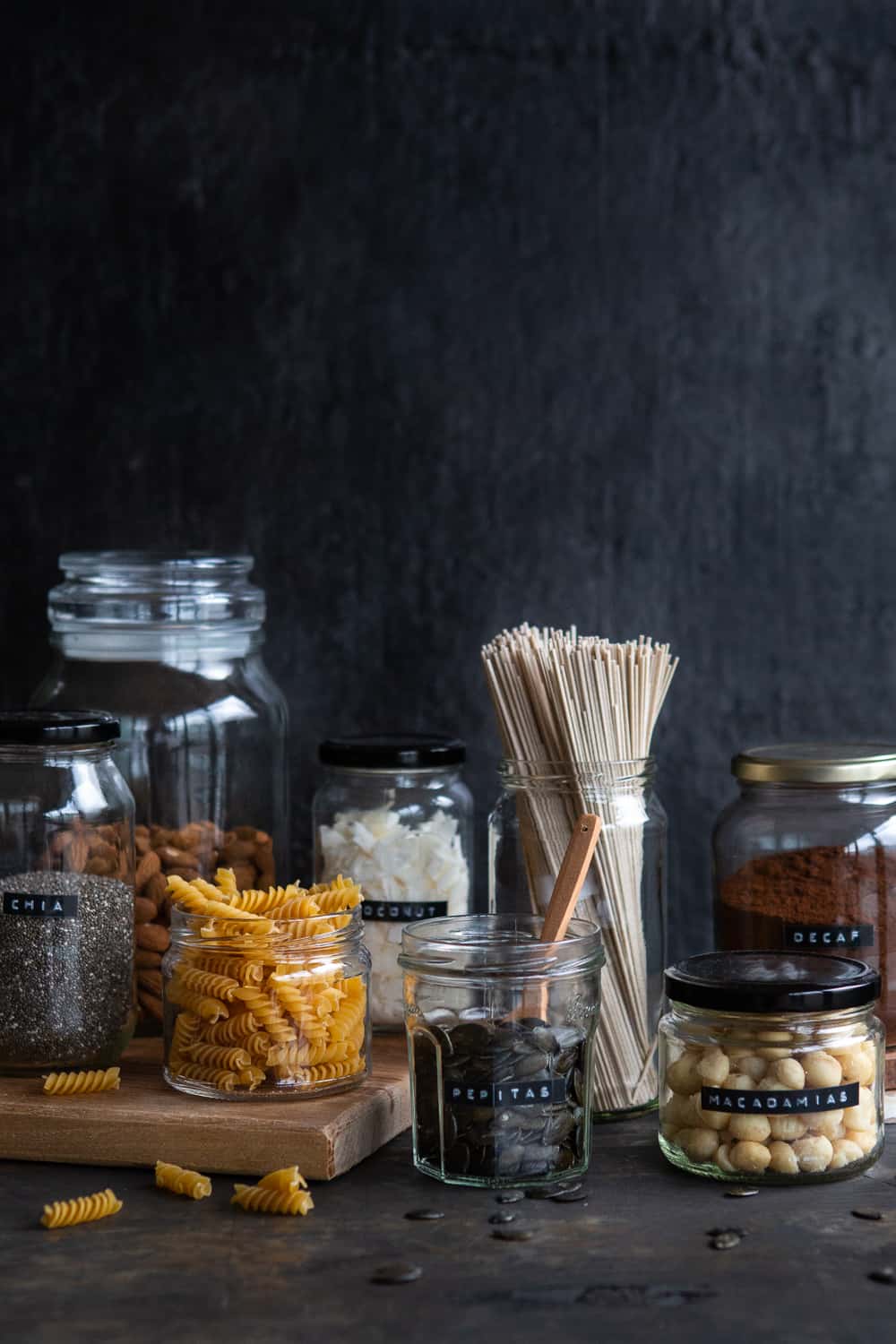
Dairy alternatives
Dairy alternatives have come a long way in the past decade, and now you can find readily available plant milk, yoghurts, sour cream, cream cheese, buttery spreads, and various artisan cheeses across most grocery stores.
While very delicious, these alternative products can quickly add up to your food bill, so if you’re trying to keep your vegan grocery list on a budget, use them in moderation.
We like soy and coconut milk for our coffee and oatmeal, coconut yogurt for granola, and the occasional vegan cheese to top our homemade vegan pizzas, burgers or just to enjoy with some crackers.
While the milk and yoghurts can be a healthy addition to your daily meals, the cheeses and cheese spreads can be very high in fat so use them more as an occasional treat. We’re all about balance here.
- Plant milk: soy, oat, almond, hazelnut, cashew, macadamia, coconut
- Yoghurt: soy, coconut, cashew almond, fruit-flavoured
- Vegan protein powders: soy, hemp, pea, brown rice
- Buttery spreads and margarine
- Soy, almond, cashew or coconut-based cheeses: mozzarella-style shreds, feta, parmesan, American-style slices, cheddar
- Vegan sour cream
- Vegan cream cheese
- Vegan ricotta
- Vegan ice-cream
- Vegan pudding cups
Meat alternatives
The alternative meat market has been booming with brands like Beyond Meat and Impossible Foods offering vegan burger patties that taste identical to their meat counterparts.
These alternative products can be especially helpful if you’re transitioning to veganism and miss the familiar flavours you’ve been accustomed to.
Similar to the dairy alternatives, these meat alternatives can get pretty costly and aren’t the best options nutrition-wise, so use them sparingly.
We personally only buy vegan sausages every now and steer clear of the other options as they can be quite processed.
- Vegan burger patties
- Vegan chicken and turkey steaks
- Seitan roasts
- Vegan cold cuts
- Vegan sausages
- Vegan bacon
- Jackfruit “pulled pork”
- Vegan nuggets
Snacks and treats
This is our miscellaneous group of snack items like crackers, granola bars, or chips and salsa.
While not necessarily a healthy food group, these items have their place on your vegan grocery list as convenience items for when you’re too busy or just want the occasional treat.
We personally don’t encourage consumption of these foods as we try and promote a healthier vegan lifestyle; however, acknowledge that sometimes these foods are an indulgent treat.
Maybe you’re in the mood for some thick hot chocolate and need vegan marshmallows for the full experience? Our guilty pleasure? Vegan almond magnums!
This section also covers the various frozen vegan meals available at most grocery stores. You can find a selection of vegan pizzas, frozen stuffed pasta, waffles, pre-made vegan burger patties, vegan puff pastries, and even dumplings.
Most of these products aren’t always automatically vegan-friendly, so we have added some notes to them to help you keep an eye out for the non-vegan ingredients when checking.
- Potato and Tortilla Chips (can contain honey, sour cream powder, sodium caseinate, some natural flavours, cheese powder, milk fats and powders including buttermilk)
- Pretzels (plain ones should normally be vegan but keep an eye out for ingredients in the flavoured varieties)
- Crackers (as above, plain ones are generally vegan, keep an eye out for the flavoured variety)
- Popcorn (can contain butter if plain)
- Store-bought dips: hummus and salsa are the safest. Check for milk in hummus.
- Oreos (accidentally vegan)
- Vegan dark chocolate and chocolate chips (things to avoid are milk solids, fats and butter)
- Vegan granola bars (things to avoid are honey, dairy chocolate or yoghurt)
- Vegan agar gummy lollies (lollies are typically made using gelatin, some food colourings and additives)
- Various biscuits (keep an eye out for butter, milk, and eggs, most vegan ones will be labelled as such)
- Vegan marshmallows (standard marshmallows are made of gelatine and colours like 120 which comes from the body and eggs of insects)
You’ll also be able to find vegan pizza, stuffed pasta, dumplings, sausage rolls, waffles, burger patties, and bakery items in the frozen section of your grocery store.
It might take you a little bit of time when you look for it the first time, but there are certainly plenty more options for vegans these days! Usually, you can rely on the packaging, saying that the product is vegan. I say “usually” because brands have been caught out to label something vegan and still use animal-derived ingredients. A typical example is honey. So be diligent and double-check the label when you first look at the product you want to buy.
Beverages
We already mentioned the wide range of plant-based milk in the dairy alternatives section, and this includes the different nut, legume, and grain milk as well as coffee creamers.
Apart from the dairy alternatives, you can reach for various teas, coffee, fruit juices, soft drinks, and alcoholic beverages. If you’re a fan of fruit juices, look for the unsweetened, 100% fruit varieties to limit your intake of added sugars.
Most alcoholic beverages aren’t vegan, which is due to the filtration process where manufactures might use gelatine, egg whites, or other animal-derived ingredients. This is commonly practised in the wine industry.
To learn more check out our detailed post on how to approach alcohol as a vegan.
We recommend Barnivore, a website where you can check whether your desired wine, beer or liquor is vegan or not.
We do keep some plant milks on hand in our pantry, though we don’t really buy fruit juices, soft drinks or alcohol. Soft drinks don’t offer anything other than simple sugars and empty calories, and we prefer to get our calories through chewable foods and not just liquids.
We do enjoy coffee with a splash of organic soy milk and warm herbal teas. We also like making homemade cold-brew tea during the warmer months—all you do is steep your tea overnight, and in the morning, you’ll have a very refreshing iced tea!
- Black coffee
- Various teas: green, black, white, herbal, and fruity teas (keep an eye out for honey in blends, also try and buy loose leaf as some brands make teabags out of plastic!)
- Plant-based milk: almond, cashew, oat, soy, coconut etc.
- Different fruit juices: apple, orange, cranberry, blueberry, fruit juice mixes. Keep in mind that they’re not all vegan. Some brands add fish oil and fish gelatine. Best to make your own at home 🙂
- Sparkling water
- Kombucha (keep an eye out for honey)
- Alcoholic beverages: wine, beer, hard liquor (as mentioned above, make sure to look for a vegan-friendly sign on the label or look up online)
Condiments
This is the most diverse bunch between all of our categories, and here you’ll find various sauces, dips and spreads, fermented foods, as well as some pantry spices that can enhance the flavours of your dishes.
Condiments can go a long way when it comes to quick meals like sandwiches or wraps and can also offer some health benefits—think the probiotics and good gut bacteria found in kimchi and sauerkraut.
Most traditional condiments do have a vegan version, though always make sure to scan the ingredients on the back of the label—one sneaky ingredient can be anchovies found in some commercial pasta sauces.
We usually keep tamari, ketchup, mustard, pickles, vegan mayo, miso, and nutritional yeast stocked in our pantry at all times. However, we do like trying some specialty Asian ingredients like different curry pastes from time to time.
We love our spices and use them in most of our vegan dishes—from cinnamon with our morning oats to various dried herbs like sweet paprika, basil and oregano in our soups and stews.
Don’t be afraid to play around with different spices—they’ll add a ton of flavour to your vegan dishes at a very low cost.
- Vegan mayo (conventional mayonnaise is egg-based)
- Ketchup
- Mustard
- Vinegar of all varieties
- Oils of all varieties
- Pickles and pickle relish
- Nutritional yeast
- Green and red curry paste (keep an eye out for fish sauce and shrimp paste)
- Miso, all varieties
- Soy sauce
- Tamari (a wheat-free alternative to soy sauce)
- Vegan Worcestershire sauce (normal one has anchovies, potential non-vegan colours and flavours)
- Hot sauce
- Jarred pasta sauce (check the label for cheese and anchovies)
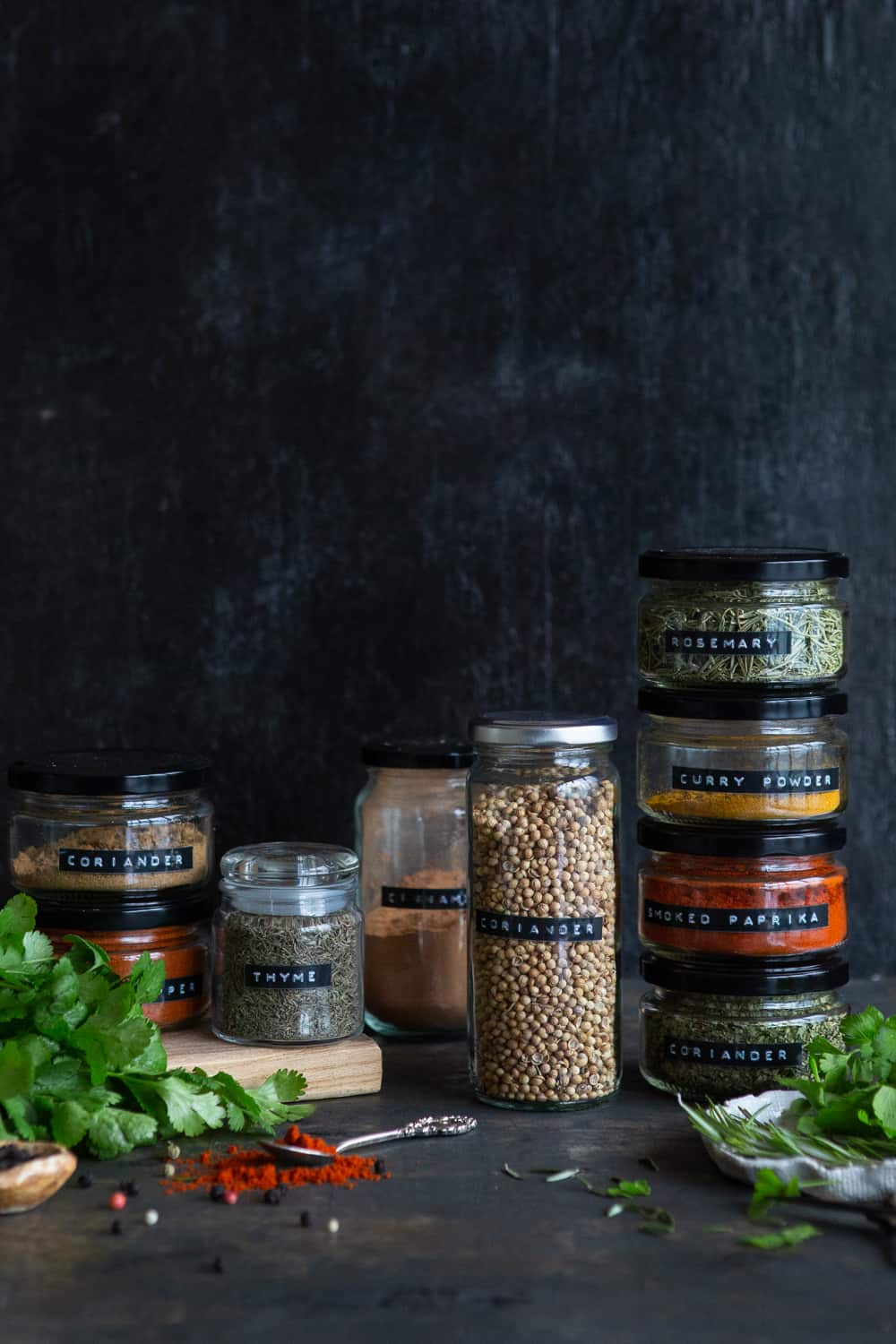
Herbs and spices
Below is a list of common herbs you can add to your shopping list to give you a range of flavour combinations in your cooking.
Some spice mixes can have sneaky ingredients like milk solids and chicken or beef flavouring.
- Cinnamon
- Cardamom pods and ground
- Allspice
- Nutmeg
- Mixed spice
- Fennel
- Ginger
- Cumin
- Turmeric
- Curry powder
- Mustard seeds
- Coriander seeds and powder
- Cumin seeds and powder
- Chilli
- Garam masala
- Black, white and cayenne pepper
- Smoked or sweet paprika
- Sumac
- Dried oregano
- Dried basil
- Dried thyme
- Dried mint
- Dried dill
- Dried sage
- Dried parsley
- Dried coriander
- Dried rosemary
- Garlic and onion powder
- Dried herb mixes (Italian seasoning, herbs de Provence)
Bread and pasta
Bread and pasta can be healthy additions to a vegan diet. Try to stick to whole-grains and avoid anything white or bleached, like white bread and white pasta.
We understand that you can’t eat 100% healthy all the time, so everything in moderation is a good starting point for your vegan journey.
- Whole-wheat bread
- Gluten-free bread (watch out for eggs and milk)
- Whole-wheat pasta, including couscous
- Gluten-free pasta: brown rice, quinoa, buckwheat and corn
- Whole-wheat pita bread and wraps
We love buying freshly baked sourdough, but we’ve been caught out a few times with them containing eggs, buttermilk or honey. So make sure you do your research and ask your local baker about the ingredients.
Miscellaneous Items
There are a few items that we weren’t sure where to put so decided to add this quick little list to add them to. These are just some of the extras that you’ll find in our pantry.
- Psyllium husk
- Cacao powder
- Coconut cream
- Shredded, desiccated and flaked coconut
- Maca powder
- Greens powder
- Dried seaweed
Vegan food shopping tips and tricks
In this section, we’re going to give you some neat little tips and tricks to set up your vegan grocery shopping for success.
Shopping online vs in person
Going to the store to buy your groceries can have its perks for new vegans as aside from getting the staples listed in your vegan grocery list, you can browse the isles and discover new and exciting vegan options.
However, this can also be tedious, depending on how comfortable you are reading labels and finding produce.
Sometimes it’s easier to shop online to control your budget, get product information and be strategic. You can use the online options and get all of your groceries delivered right to your door or pick up your order in store.
We still prefer getting our produce from farmers markets or bulks store as we like choosing what looks and smells fresh and inviting. This way, we also limit wastage because we only buy what we know we’ll use.
Customise your groceries
Use all the different items featured in our simple vegan shopping list as a stepping stone and make sure your groceries are working for you and your goals—whether it’s health, comfort, convenience or budget.
Eating clean and healthy
If your focus is on clean eating and weight loss, stick to the first few sections in this article: the vegetables, fruits, grains, legumes, nuts, and seeds.
These will form the base for a whole-foods plant-based diet that will allow you to thrive and nourish your body with healing vegan foods.
Build your weekly meal plan around plenty of fresh, seasonal fruits and vegetables, along with whole grains, legumes, and some nuts and seeds for fat and protein.
Looking for comfort
If you’ve been eating meat and dairy products your whole life and are just transitioning to a vegan lifestyle, it’s only natural that you might miss the comfort of the familiar flavours you’ve grown up with.
Reach for more meat and dairy alternatives that mimic the taste and textures of the animal-derived foods to help you along on your journey. In time, you’ll train your palate to enjoy more plant-based foods, and you’ll find yourself not missing the meat and dairy products at all!
Frozen and canned for convenience
Perhaps you have a busy job and a hectic schedule that doesn’t allow for much leisurely cooking. Go for the canned beans and legumes, frozen vegetables, and convenient condiments to help you make delicious vegan meals in minutes.
Read more: 12 Ways To Use a Can of Chickpeas (15-Minute Recipes)
On a budget/sustainable
Finally, if you’re working with a tight food budget or you’re trying to reduce your environmental footprint and transition to a zero-waste lifestyle, reach for the bulk bins in your nearest grocery store.
Buy dried legumes, grains, dried fruits, and nuts or seeds in bulk as they are both cheaper and zero-waste. Bring your own containers to the bulk bins so you can skip the plastic packaging.
To make things easier on yourself, soak your grains and legumes overnight to shorten their cooking time and cook larger batches on the weekends to last you during the week.
Make the vegan grocery list work for you
Now that you’ve seen the abundance of vegan foods available to you use this list as a starting point and make it your own. You don’t need to eat broccoli if you don’t like the taste—just get the vegetables that you like, and you know you’ll enjoy cooking with.
Remember this is your vegan grocery list, and the list should work in your favour, not the other way around.
Set your list around the basics: some seasonal fruits and vegetables, a couple of grain, nut, and seed options and some dried or canned legumes. Next, supplement with the condiments and alternative products depending on your desired meals.
And if you’re unsure what you’d like to cook, look through our recipe collection (or other vegan blogs) for some inspiration and new ideas.
Once you start experimenting in the kitchen, you’ll figure out exactly which ingredients and flavour combinations you like the most, and you can reach for them more often in the future.
We hope that our simple vegan grocery list will serve you as a guide to enjoy more plant-based ingredients and gain confidence in the kitchen. Happy shopping!

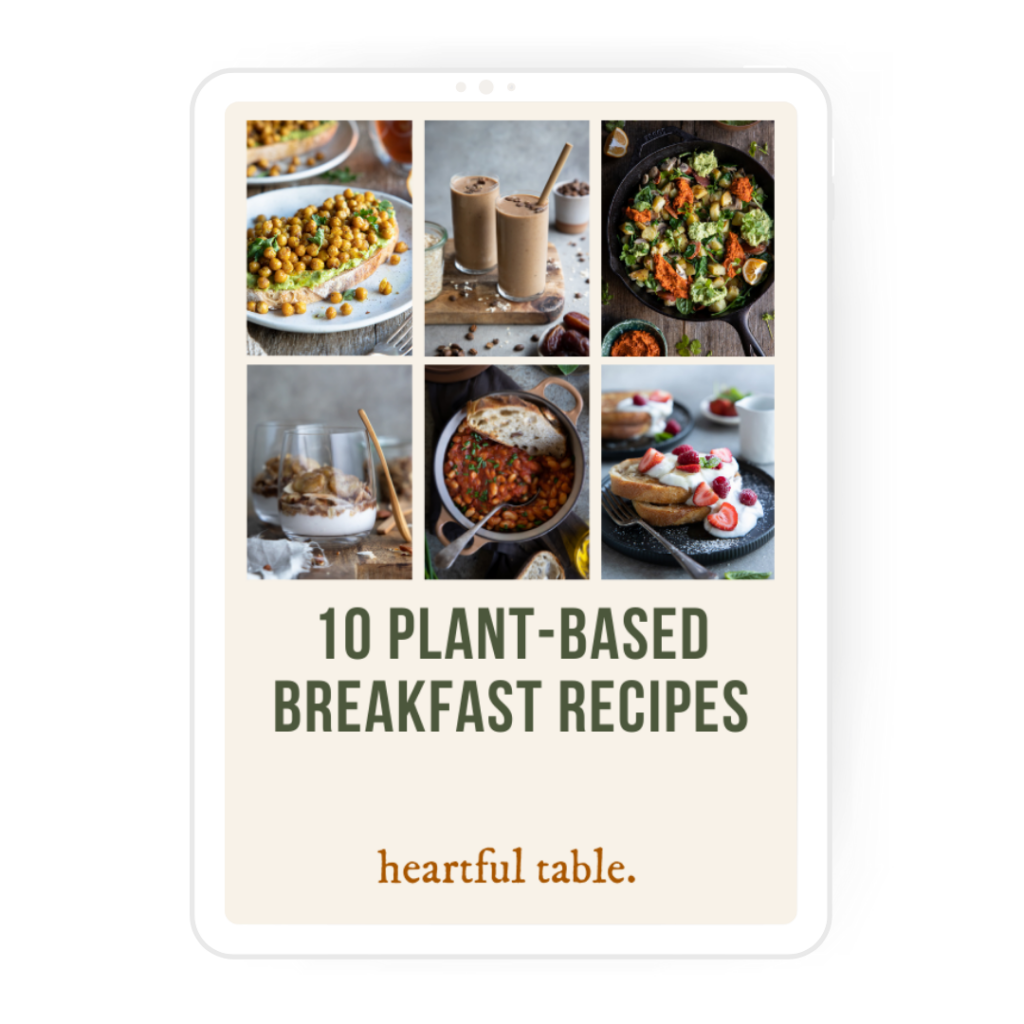


Thank you very much for putting this list together. I’ve printed it and believe it will be most helpful while shopping!
Thanks again!
Glad it was of help, Peggy! Happy shopping 🙂
Such a helpful article, thank you so much. I am on my journey to becoming vegetarian then transitioning to vegan. This has been a great start to help me. Hopefully in 3 to 5 years I will be switched over and my health will thank me. Thanks so much! 🙂
I’m so glad you found it useful! Best of luck on your journey and thank you for your comment 🙂
Thanks for this article with grocery lists. This should help many new and aspiring vegans, as well as their friends and family members know how to shop.
I would like to see an article, you both write so well, about low fiber vegan options that are nutrient dense. I’ve eaten vegan for four years, and have no problem getting several times the daily recommended fiber. Again thanks for writing very informative works to support healthful eating.
Thanks for the suggestion, Rhea. You’re right, plants naturally contain a lot of fiber, so we’d need to do some digging!